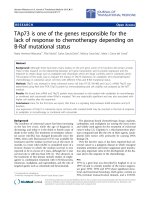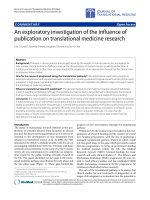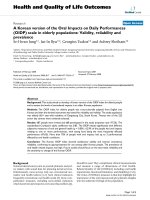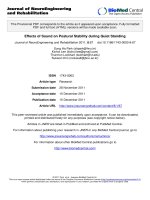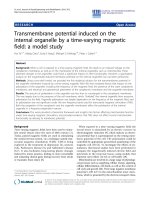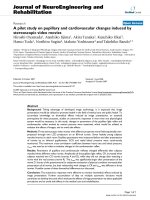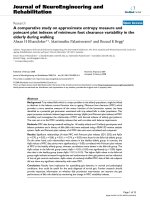Báo cáo hóa học: " Bessel potential space on the Laguerre hypergroup Taieb Ahmed" doc
Bạn đang xem bản rút gọn của tài liệu. Xem và tải ngay bản đầy đủ của tài liệu tại đây (228.45 KB, 9 trang )
RESEARCH Open Access
Bessel potential space on the Laguerre
hypergroup
Taieb Ahmed
Correspondence:
Faculty of Sciences of Tunis,
Department of Mathematics,
University of Tunis II,1060,Tunis,
Tunisia
Abstract
In this article, we define the fractional differentiation D
δ
of order δ, δ > 0, induced by
the Laguerre operator L and associated with respect to the Haar measure dm
a
.We
obtain a characterization of the Bessel potential space
L
p
δ
(K
)
using D
δ
and different
equivalent norms.
Keywords: Heat-diffusion Poisson semigroups, Fractional power, Riesz potential, Frac-
tional differentiation
1 Introduction
During the second half of the twentieth century (until the 1990s), the Continuous
Time Random Walk (CTRW) method was practically the only tool available to
describe subdiffusive and/or superdiffusive phenomena associated with complex sys-
tems for many groups of research. The main reason behind the usefulness of fractional
derivatives have been until this moment the close link that exists between fractional
models and the so called Jump stochastic models, such as the CTRW or those of the
multiple trapping type.
Note that fractional operators also provide a method for reflecting the memory prop-
erties and non-locality of many anomalou s processes. In any case, at the moment it is
not clear what is the best fractional time derivative or the spatial fractional derivative
to be used in the different models.
Fractional calculus deals with the study of so-called fractional order integral and
derivative operators over real or complex domains and their applications.
Since 1990, there has been a spectacular increase in the use of fractional models to
simulate the dynamics of m any different anomalous processes, especially those invol-
ving ultraslow diffusion. We hereby propose a few examples of fiel ds where t he frac-
tional models have been used: materials theory, transpo rt theory, fluid of contaminant
flow phenomena through heterogeneous porous media, physics theory, electromagnetic
theory, thermodynamics or mechanics, signal theory, chaos theory and/or fractals, geol-
ogy and astrophysics, biology and other life sciences, economics or chemistry, etc.
As one would expect, since a fractional derivative is a generalization of an ordinary
derivative, it is going to lose many of its basic properties. For example, it loses its geo-
metric or physical interpretation but the index law is only valid when working on very
specific function spaces and the derivative of the product of two functions is difficult
to obtain and the chain rule is not straightforward to apply.
Ahmed Advances in Difference Equations 2011, 2011:4
/>© 2011 Ahmed; licensee BioMed Central Ltd. This is an Open Acces s article distri buted un der the terms of the Creative Commons
Attribution License ( which permits unrestricted use, distr ibut ion, and reprodu ction in
any medium, provided the original work is properly cited.
It is natural to ask then, what properties fractional derivatives have that make them
so suitable for m odeling certain complex systems. The answer lies in the property
exhibited by many of the aforementioned systems of non-local dynamics, that is, the
processes dynamics have a certain degree of memory. While fractional operators natu-
rally incorporate the interesting property of no locality. They do lose some of the typi-
cal, basic properties of ordinary differential operators. The ordinary derivative is
clearly, by definition, local [1].
According to the ideas presented by Stein [2], the fundamental operators of the har-
monic analysis (fractional integrals, Riesz transformation, g-functions, ) can be con-
sidered in the context of the Laguerre operator L.
It is important to mention that this way of describing harmonic operators in the
Laguerre context was initiated by Muckenhoupt [3].
The organization of the article is as follows. Section 2 contains some basic facts
needed in the sequel about the Laguerre hypergroup. Section 3 is devoted to some
gen eration and representation for the semigro ups also we define the fractional power,
the heat-diffusion and the Poisson-Laguerre semigroups based on a Laguerre operator.
Finally, Sect. 4 is devoted to proving the main result of this article (Theo rem 1) where
we establish that ||D
δ
f||
p
and ||f||
δ,p
are equivalent when the fractional differentiation
D
δ
is defined for δ >0.
2 Preliminary
In this section we set some notations and we recall some basic results in harmonic
analysis related to Laguerre hypergroups (see [4-6]).
First we begin with some notation.
• We denote by
K =
[
0, ∞
]
×
R
equipped with the weighted Lebesgue measure m
a
on
K
given by
dm
α
(x, t)=
x
2
α+
1
dxdt
π
(
α +1
)
, α ≥ 0
.
For every 1 ≤ p ≤∞,wedenoteby
L
p
(
K
)
= L
p
(
K,dm
α
)
the spaces of complex-valued
functions f, measurable on
K
such that:
|
|f ||
L
p
(K)
=(
K
|f (x, t)|
p
dm
α
(x, t))
1
p
< ∞,ifp ∈ [1, ∞[
.
and
|
|f ||
L
∞
(K)
= ess sup
(
x,t
)
∈K
|f (x, t)|
.
•
D
(
K
)
the subspace of
S
(
K
)
of functions ψ satisfying the following:
(i) There exists m
0
Î N satisfying ψ(l, m) = 0, for all
(
λ, m
)
∈
K
such that m > m
0
.
(ii) for all m ≤ m
0
,thefunctionl ↦ ψ(l,m)is
C
∞
on ℝ with compact support and
vanishes in a neighborhood of zero.
•
D
(
K
)
the topological dual space of
D
(
K
)
.
•
ˆ
K
=
R
×
N
the dual space of
K
.
Ahmed Advances in Difference Equations 2011, 2011:4
/>Page 2 of 9
•
L
p
(
ˆ
K
)
= L
p
(
ˆ
K
)
,dγ
α
)
the spaces of complex-valued functions f, measurable on
ˆ
K
such
that:
|
|f ||
L
p
(
ˆ
K)
=(
ˆ
K
|f (λ, m)|
p
dγ
α
(λ, m))
1
p
< ∞,if1≤ p <
∞
and
||f ||
L
∞
(
ˆ
K)
= ess sup
(
λ,m
)
∈
ˆ
K
|f (λ, m)
|
where dg
a
(l, m) being the positive measure defined on
ˆ
K
by:
ˆ
K
f (λ, m)dγ
α
(λ, m)=
∞
m=0
L
(α)
m
(0)
R
f (λ, m)|λ|
α+1
dλ
.
For (x, t)]0,∞[× ℝ and a Î [0, ∞[, we consider the following partial differential
operator, named the Laguerre operator:
L =
∂
2
∂x
2
+
2α +1
x
∂
∂x
+ x
2
∂
2
∂t
2
(1)
Remark 1. For a = n -1,n Î N*, the operator L is the radial part of the sublapla-
cian on the Heisenberg group ℍ
n
.
For
(
λ, m
)
∈
ˆ
K
and
(
x, t
)
∈
K
,weput
ϕ
λ,m
(
x, t
)
= e
iλt
L
(
α
)
m
(
|λ|x
2
)
,where
L
(α)
m
is the
Laguerre function defined on [0, ∞]by
L
(α)
m
(
x
)
= e
−x
2
L
(α)
m
(
x
)
/L
(α)
m
(
0
)
and
L
(α
)
m
is the
Laguerre polynomial of degree m and order a.
Prop osition 1. For
(
λ, m
)
∈
ˆ
K
, the function
l,m
, is t he unique solution of the follow-
ing problem:
⎧
⎨
⎩
Lu = −4|λ|(m +
α+
1
2
)u
,
u(0, 0) = 1,
∂
x
u(0, t)=0, ∀t ∈ R,
We denote by:
c
λ,m
=4|λ|(m +
α+1
2
)=|(λ, m)|
ˆ
K
.
Definition 1. (i) The generalized Fourier transform F is defined on
L
1
(
K
)
by:
F( f )(λ, m)=
K
f (x, t)ϕ
−λ,m
(x, t)dm
α
(x, t), (λ, m) ∈
ˆ
K
(ii) We have also the inverse formula of the generalized Fourier transform F
-1
on
by:
F
−1
(f )(x, t)=
ˆ
K
f (λ, m)ϕ
λ,m
(x, t)dγ
α
(λ, m), (x, t) ∈ K
.
For
(
λ, m
)
∈
ˆ
K
, we denote by: P
(l,m)
f = F(f )(l, m)
l,m
.
Ahmed Advances in Difference Equations 2011, 2011:4
/>Page 3 of 9
3 The heat-diffusion and the Poisson-Laguerre semigroups
3.1 The heat-diffusion semigroup
The heat-diffusion semigroup {T
t
}
t≥0
, associated to (-L), is then defined by
T
t
f (y, s):=e
−tL
f (y, s)
=
ˆ
K
e
−tc
λ,m
P
(λ,m)
f (y, s)dγ
α
(λ, m)
=
ˆ
K
K
e
−tc
λ,m
f (u, v)ϕ
−λ,m
(u, v)ϕ
λ,m
(y, s)dm
α
(u, v)dγ
α
(λ, m)
=
K
f (u, v)[
ˆ
K
e
−tc
λ,m
ϕ
−λ,m
(u, v)ϕ
λ,m
(y, s)dγ
α
(λ, m)]dm
α
(u, v
)
=
K
f (u, v)T
t
((u, v), (y, s))dm
α
(u, v).
where
T
t
((u, v), (y, s)) =
ˆ
K
e
−tc
λ,m
ϕ
−λ,m
(u, v)ϕ
λ,m
(y, s)dγ
α
(λ, m
)
is the heat kernel of the integral representation T
t
f.
Proposition 2. This semigroup {T
t
}
t≥ 0
is a strongly continuous semigroup on
L
p
(
K
)
with infinitesimal generator L(see [7]).
Proof. Let
f ∈ L
p
(
K
)
then
lim
s
→
t
||T(s)f −T(t)f ||
L
p
(K)
= lim
s
→
t
||T(s)−T(t))f ||
L
p
(K)
≤ lim
s
→
t
||T(s)−T(t)||
L
p
(K)
||f ||
L
p
(K)
=0
.
By the definition of t he heat-diffusion semigroup {T
t
}
t≥0
, we establish the following
result.
Corollary 1. For
(
μ, η
)
∈
ˆ
K
, we have
T
t
ϕ
μ,
η
(y, s)=e
−tc
μ,η
ϕ
μ,
η
(y, s)
,
Proof. we have
T
t
ϕ
μ,η
(y, s)=
ˆ
K
K
e
−tc
λ,m
ϕ
μ,η
(u, v)ϕ
−λ,m
(u, v)ϕ
λ,m
(y, s)dm
α
(u, v)dγ
α
(λ, m)
=
K
ϕ
μ,η
(u, v)(
ˆ
K
e
−tc
λ,m
ϕ
−λ,m
(u, v)ϕ
λ,m
(y, s)dγ
α
(λ, m))dm
α
(u, v
)
=
K
ϕ
μ,η
(u, v)F
−1
(e
−tc.,.
ϕ
−
.,.
(u, v))(y, s)dm
α
(u, v)
= F(F
−1
(e
−tc.,.
ϕ
.,.
(y, s)))(−μ, η)
= e
−tc
μ,η
ϕ
μ,
η
(y, s).
3.2 The fractional power
For δ > 0, the negative power L
-δ
of L with respect to the measure dm
a
is defined, as
in [8], by
L
−δ
f (y, s):=
ˆ
K
P
(λ,m)
f
(y, s)
c
δ
λ,m
ϕ
λ,m
(y, s)dγ
α
(λ, m), f ∈ L
2
(K,dm
α
)
.
Ahmed Advances in Difference Equations 2011, 2011:4
/>Page 4 of 9
It is not hard to prove that L
-δ
can be expressed, for
f ∈ L
2
(
K,dm
α
)
, by means of the
following integral
L
−δ
f (y, s)=
1
(δ)
∞
0
t
δ−1
T
t
f (y, s)dt
.
L
-δ
is also called δth fractional integral associated with L. This kind of fractional inte-
grals has been investigated by several authors ([9-12]).
Corollary 2. If f(y, s)=
l,m
(y, s), we have:
L
−δ
ϕ
λ,m
(y, s)=
1
c
δ
λ
,
m
ϕ
λ,m
(y, s)
.
Proof.Theproofistrivialbyusing
(δ)=
∞
0
t
δ−1
e
−t
d
t
and the change of variable
u
= t
√
c
λ,m
.
3.3 The Poisson-Laguerre semigroup
The Poisson-Laguerre semigroup {P
t
}
t≥0
, associated to (-L), is given by
P
t
f (y, s):=e
−tL
1/2
f (y, s)
=
ˆ
K
e
−tc
1/2
λ,m
[P
(λ,m)
f ](y, s)dγ
α
(λ, m)
.
where L
1/2
is defined by using the spectral theorem.
Now, by using the Bochner subordination formula
e
−β
=
β
√
4π
∞
0
s
−3/2
e
−s
e
−β
2
/4s
ds
.
After the change of variable
w =
t
2
c
λ,m
4
s
, we obtain:
P
t
f (y, s
)=
1
√
π
∞
0
e
−w
√
w
T
t
2
4
w
f (y, s
)dw
.
Proposition 3. This semigroup {P
t
}
t≥ 0
is also a strongly contin uous semigroup on
L
p
(
K
)
,with infinitesimal generator L
1/2
.
Proof. We use the fact that
T
t
2
4
w
is strongly continuous.
By the definition of the Poisson-Laguerre semigroup {P
t
}
t≥0
,we establish also the fol-
lowing result
Corollary 3. For
(
μ, η
)
∈
ˆ
K
, we have
P
t
ϕ
μ,
η
(y, s)=e
−t
√
c
μ,η
ϕ
μ,
η
(y, s)
.
Proof.Wereplacec
μ,h
by
√
c
μ,η
in the proof of Corollary 1, then the result is
immediate.
3.4 The Riesz potential
For δ > 0, the Riesz potential of order δ, I
δ
, with respect to the measure dm
a
is defined,
as in the classical case [13], by
I
δ
:=
(
−L
)
−δ/2
.
Ahmed Advances in Difference Equations 2011, 2011:4
/>Page 5 of 9
Proposition 4. The Riesz potential can be also writed as
I
δ
f (y, s)=
1
(δ)
∞
0
t
δ−1
P
t
f (y, s)dt
.
Proof. By using (-L)
-δ
, we have
I
δ/2
f (y, s)=
1
(δ/2)
∞
0
t
δ/2−1
T
t
f (y, s)dt
.
After to replace P
t
f(y, s) with his expression, the change of variable
t
=
t
2
4
u
and the
property of the function Gamma, we obtain:
1
(δ/2)
∞
0
t
δ/2−1
T
t
f (y, s)dt −
1
(δ)
∞
0
t
δ−1
P
t
f (y, s)dt =0
.
Corollary 4. If f(y, s)=
l,m
(y, s), we have
I
δ
ϕ
λ,m
(y, s)=
1
c
δ/2
λ
,
m
ϕ
λ,m
(y, s)
.
Proof.Theproofistrivialbyusing
(δ)=
∞
0
t
δ−1
e
−t
d
t
and the change of variable
u
= t
√
c
λ,m
.
4 Characterization of the potential spaces
L
p
δ
(K
)
4.1 The fractional differentiation
Following the classical case, the fractional diff erentiation D
δ
of order δ >0onthe
Laguerrre hypergroup is defined formally by
D
δ
:=
(
−L
)
δ
2
.
Corollary 5. In the case of 0<δ <1,we have
D
δ
ϕ
λ,m
(y, s)=c
δ/2
λ
,
m
ϕ
λ,m
(y, s)
.
Proof. In the case of 0 <δ < 1, we can write using [13] that
D
δ
f (y, s)=
1
c
δ
∞
0
t
−δ−1
(P
t
f −f )(y, s)dt
.
(2)
where
c
δ
=
∞
0
u
−δ−1
(e
−u
− 1)du
.
By a change of variable
u
= t
√
c
λ,m
and the definition of c
δ
, we have again:
D
δ
ϕ
λ,m
(y, s)=c
δ/2
λ
,
m
ϕ
λ,m
(y, s)
.
Remark 2. Observe that:
I
δ
(
D
δ
f
)
= D
δ
(
I
δ
f
)
= f
.
Ahmed Advances in Difference Equations 2011, 2011:4
/>Page 6 of 9
As an application of the operator fractional derivative D
δ
, we will give a characteriza-
tion of the potential spaces
L
p
δ
(K
)
, which is simpler and more powerful, valid for any 1
<p < ∞ and δ ≥ 0.
4.2 Bessel potential space on
K
We mention that the Laguerre potential spaces is defined as
L
p
δ
(
K
):={f :(I − L)
δ/2
f ∈ L
p
(
K
), 1 < p < ∞, δ ≥ 0
}
equipped with the norm
|
|f ||
p,δ
= ||(I − L)
δ/2
f ||
L
p
(
K
)
.
Let us define the Laguerre Bessel operator as
(I − L)
−δ/2
f (y, s):=
ˆ
K
(1 + c
λ,m
)
−δ/2
P
(λ,m)
f (y, s)dγ
α
(λ, m
)
where c
l,m
is the homogenous norm of
(
λ, m
)
∈
ˆ
K
Proposition 5. If 0 ≤ δ
1
<δ
2
then
L
p
δ
2
(K) ⊂ L
p
δ
1
(K
)
for each 1<p < ∞
Proof. We have
||f ||
p,δ
1
=
K
|
ˆ
K
(1 + c
λ,m
)
δ
1
/2
P
(λ,m)
f (y, s)dγ
α
(λ, m)|
p
dm
α
(y, s)
≤
K
|
ˆ
K
(1 + c
λ,m
)
δ
2
/2
|P
(λ,m)
f (y, s)|dγ
α
(λ, m)|
p
dm
α
(y, s
)
= ||
f
||
p
, δ
2
.
Now, let us establish a relation among different norms of potential spaces.
Proposition 6. Given 1<p < ∞ and δ ≥ 1, if
f ∈ L
p
δ
(K
)
then
(i)
f ∈ L
p
δ
−1
(K
)
.
(ii)
Lf ∈ L
p
δ
−1
(K
)
.
Moreover,
||f ||
p
,δ−1
+ ||Lf ||
p
,δ−1
≤ C
p
||f ||
p
,δ
.
Proof. (i) is immediate, since
L
p
δ
2
⊂ L
p
δ
1
such that δ
1
<δ
2
.
(ii) We use the fact that L is symmetric, F(Lf)=-c
l,m
F(f)=-c
l,m
F(f)and
L
p
δ
+1
(K) ⊂ L
p
δ
(K
)
, then:
||Lf ||
p
p,δ−1
= ||(I − L)
(δ−1)/2
Lf ||
p
p,δ−1
=
K
|(I − L)
(δ−1)/2
Lf |
p
dm
α
=
K
|
ˆ
K
(1 + c
λ,m
)
(δ−1)/2
P
(λ,m)
(Lf )dγ
α
(λ, m)|
p
dm
α
(x, t)
=
K
|
ˆ
K
(1 + c
λ,m
)
(δ−1)/2
F(Lf )(λ, m)ϕ
λ,m
(x, t)dγ
α
(λ, m)|
p
dm
α
(x, t)
=
K
|
ˆ
K
(1 + c
λ,m
)
(δ−1)/2
c
λ,m
F(f )(λ, m)ϕ
λ,m
(x, t)dγ
α
(λ, m)|
p
dm
α
(x, t
)
≤
K
|
ˆ
K
(1 + c
λ,m
)
(δ−1)/2
F(f )(λ, m)ϕ
λ,m
(x, t)dγ
α
(λ, m)|
p
dm
α
(x, t)
=
K
|
ˆ
K
(1 + c
λ,m
)
(δ−1)/2
P
(λ,m)
(f )(x, t)dγ
α
(λ, m)|
p
dm
α
(x, t)
= ||Lf ||
p
p,δ+1
≤||f ||
p
p
,δ
.
Ahmed Advances in Difference Equations 2011, 2011:4
/>Page 7 of 9
Then, we get
|
|f ||
p
,δ−1
+ ||Lf ||
p
,δ−1
≤ C
p
||f ||
p
,δ
.
Next we show that i f
f ∈ L
p
δ
(K
)
is equivalent to
D
δ
f ∈ L
p
(
K
)
. The main tool is
Meyer’s multiplier theorem and let us underline that the definition of D
δ
on all t he
spaces
L
p
δ
(K
)
,1<p < ∞, is also based on an application of Meyer’s theorem [13].
Theorem 1. Let δ ≥ 0 and 1<p < ∞, we have:
f ∈ L
p
δ
(K
)
if and only if
D
δ
f ∈ L
p
(
K
)
Moreover, there exist a constant B
p,δ
and A
p,δ
such
that:
B
p
,δ
||f ||
p
,δ
≤||D
δ
f ||
p
(K) ≤ A
p
,δ
||f ||
p
,δ
.
To prove this result we need the following lemma.
Lemma 1. Let
f ∈ L
p
δ
(K
)
and ψ =(I - L)
δ/2
f, for δ ≥ 0 and 1<p < ∞, then:
(i)
P
λ,m
D
δ
f = c
δ
/
2
λ
,
m
P
λ,m
f
.
(ii) P
l,m
ψ =(1+c
l,m
)
-δ/2
P
l,m
f.
Proof.
(i) We have
F( D
δ
f )=F((−L)
δ
/
2
f )
=< (−L)
δ/2
f , ϕ
−λ,m
> dm
α
=< f ,(−L)
δ/2
ϕ
−λ,m
> dm
α
= c
δ/2
λ
,
m
F( f ).
Then
P
λ,m
(D
δ
f )=c
δ/2
λ
,
m
P
λ,m
f
.
(ii) We know that
ψ =(I − L)
δ/2
f
= F
−1
[
(
1+c
λ,m
)
−δ/2
F
(
f
)]
then
F
(
ψ
)
=
(
1+c
λ,m
)
−δ/2
F
(
f
).
Using the definition of P
l,m
, we obtain
P
λ,m
ψ =
(
1+c
λ,m
)
−δ/2
P
λ,m
f
.
Now let to prove the Theorem 1
Proof. Let
f ∈ L
p
δ
(K
)
and ψ =(I - L)
δ/2
f, then:
D
δ
f =
ˆ
K
c
δ/2
λ,m
P
λ,m
f dγ
α
(λ, m)
=
ˆ
K
(
c
λ,m
1+c
λ,m
)
δ/2
P
λ,m
ψdγ
α
(λ, m)
.
Ahmed Advances in Difference Equations 2011, 2011:4
/>Page 8 of 9
Since ||f||
p,δ
=||ψ||
p
, by Meyer’s multipliers theorem and using the multipliers h(z)=
(1 + z)
-δ/2
, we obtain that:
|
|D
δ
f ||
p
≤ A
p
,δ
||ψ||
p
= A
p
,δ
||f ||
p
,δ
.
To prove the converse, suppose
D
δ
f ∈ L
p
(
K
)
and consider
ψ =(I − L)
δ/2
f
=
ˆ
K
(1 + c
λ,m
)
δ/2
P
λ,m
f dγ
α
(λ, m)
=
ˆ
K
(
1+c
λ,m
c
λ,m
)
δ/2
P
λ,m
(D
δ
f )dγ
α
(λ, m)
.
so by Meyer’s multipliers theorem, using the multiplier h(z)=(z +1)
δ/2
, we have:
|
|f ||
p
,δ
= ||ψ ||
p
≤ B
p
,δ
||D
δ
f ||
p
.
Finally, we can write that
L
p
δ
(K)={f : D
δ
f ∈ L
p
(K), δ ≥ 0, 1 < p < ∞}
.
Competing interests
The author declares that they have no competing interests.
Received: 17 December 2010 Accepted: 19 May 2011 Published: 19 May 2011
References
1. Trujillo JJ: On best fractional derivative to be applied in fractionel modeling. 3rd IFAC Workshop 2008 Fractional
Differentiation and its Applications, Ankara, Turkey 2008.
2. Stein EM: Topics in Harmonic analysis related to the Littlewood-Paley theory. Annals of Mathematical Studies,
Princenton University Press, Princenton 1970, 63.
3. Muckenhoupt B: Poisson integrals for Hermite and Laguerre expansions. Trans Am Math Soc 1969, 139:231-242.
4. Assal M, Nessibi MM: Soblev type spaces on the dual of the Laguerre hypergroup. Potential Anal 2004, 20:85-103.
5. Kortas H, Sifi M: Lévy-Khintchine formula and dual convolution semigroups associated with Laguerre and Bessel
functions. Potential Anal 2001, 15:43-58.
6. Nessibi MM, Trimeche K: Inversion of the Radon transform on the Laguerre hypergroup by using generalized
wavelets. J Math Anal Appl 1997, 208 :337-363.
7. Pazy A: Semigroups of Linear Operators and Applications to Partial Diffrential Equations. Springer-Verlag, New York;
1983.
8. Stempak K, Torrea JL: Poisson integrals and Riesz transforms for Hermite function expansions with weights. J Funct
Anal 2003, 202:443-472.
9. Gasper G, Stempak K, Trebels W: Fractional integration for Laguerre expansions. Methods Appl Anal 1995, 2:67-75.
10. Graczyk P, Loeb J-L, Lopez IA, Nowak A, Urbina W: Higher order Riesz transforms, fractional derivatives and Sobolev
spaces for Laguerre expansions. J Math Pure et Appl 2005, 84(3):375-405.
11. Kanjin Y, Sato E: The Hardy-Littlewood theorem on fractional integration for Laguerre series. Proc Am Math Soc
1995, 123:2165-2171.
12. Stempak K: Heat-diffusion and Poisson integrals for Laguerre expansions. Tohoku Math J 1994, 46(1):83-104.
13. Lopez IA, Urbina WO: Fractional differentiation for the Gaussian measure and applications. Bulletin des sciences
mathematiques 2004, 128:587-603.
doi:10.1186/1687-1847-2011-4
Cite this article as: Ahmed: Bessel potential space on the Laguerre hypergroup. Advances in Difference Equations
2011 2011:4.
Ahmed Advances in Difference Equations 2011, 2011:4
/>Page 9 of 9
